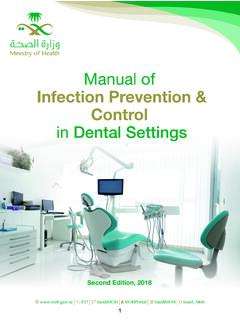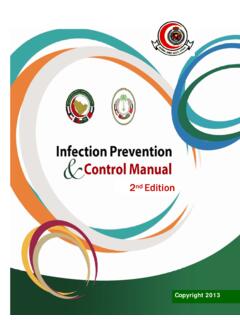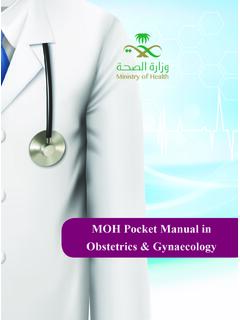Transcription of MOH Pocket Manual in Critical Care - moh.gov.sa
1 MOH Pocket Manual in Critical Care3 MOH Pocket Manual in Critical CareTABLE OF CONTENTSINTRACRANIAL HEMORRHAGE9 ISCHEMIC STROKE910 TRAUMATIC BRAIN INJURY1111 CNS INFECTION1512 STATUS EPILEPTICUS1813 GUILLIAN-BAR R SYNDROME2114 MYASTHENIA GRAVIS2315 HYPERTENSIVE CRISIS2616 ACUTE CORONARY SYNDROME2917 VENTICULAR TACHYCARDIA 3518 SUPRAVENTRICULAR TACHYCADIA3919 BRADYARRHYTHMIAS4220 HEART FAILURE 4321 SHOCK 4522 ACUTE EXACERBATION OF CHRONIC OBSTRUCTIVE PULMONARY DISEASE4823 STATUS ASTHMATICUS24 ACUTE RESPIRATORY DISTRESS SYDROME25 PNEUMONIA26 PULMONARY EMBOLISM 27 CHEST TRAUMA28 MECHANICAL VENTILATION29 GASTROINTESTINAL BLEEDING30 VARICEAL BLEEDING404 MOH Pocket Manual in Critical CareACUTE LIVER FAILURE ALF50 HEPATIC ENCEPHALOPATHY 60 ACUTE PANCREATITIS80 ACUTE MESENTERIC ISCHEMIA (BOWEL ISCHEMIA) 81 INTESTINAL PERFORATION/OBSTRUCTION82 COMPARTMENT SYNDROMES83 ACUTE RENAL FAILURE84 RHABDOMYOLYSIS85 DISSEMINATED INTRAVASCULAR COAGULATION (DIC) 86 SICKLE CELL CRISIS87 SEPTIC SHOCK 88 ANAPHYLAXIS89 SEVERE MALARIA90 TETANUS91 HYPERNATRAEMIA92 HYPONATRAEMIA93 HYPERKALAEMIA 101 HYPOKALAEMIA102 HYPERGLYCEMIC HYPEROSMOTIC STATE (HHS)
2 103 HYPOGLYCEMIADKA104 THYROTOXIC CRISIS 105 MYXEDEMA COMA106 DISORDERS OF TEMPERATURE CONTRO107 OPIOID POSITIONING108 ORGANOPHOSPHATE POISONING1095 MOH Pocket Manual in Critical CarePARACETAMOL POISONING110 INHALED POISONING CO150 ALCOHOL TOXICITY151 REFERENCES 125 ALPHAPITICAL DRUG INDEX3356 MOH Pocket Manual in Critical CareIntracranial hemorrhageOverview The pathological accumulation of blood within the cranial vault) may occur within brain parenchyma or the surround-ing meningeal spaces. Intracerebral hemorrhage accounts for 8-13% of all strokes and results from a wide spectrum of disor-ders. Intracerebral hemorrhage is more likely to result in death or major disability than ischemic stroke or subarachnoid hem-orrhage. Intracerebral hemorrhage and accompanying edema may disrupt or compress adjacent brain tissue, leading to neu-rological dysfunction.
3 Substantial displacement of brain paren-chyma may cause elevation of intracranial pressure (ICP) and potentially fatal herniation syndromes. Causes of Intracranial hemorrhage : Possible causes are as follows:- Hypertension- Arterio-Venous malformation- Aneurysmal rupture- Intracranial neoplasm- Coagulopathy- Hemorrhagic transformation of an ischemic infarct- Cerebral venous thrombosis7 MOH Pocket Manual in Critical care - Sympathomimetic drug abuse- Sickle cell disease- Infection- Vasculitis- TraumaClinical Presentation History:Onset of symptoms of intracerebral hemorrhage is usually during daytime activity, with progressive ( , min-utes to hours) development of the following: - Alteration in level of consciousness (approximately 50%)- Nausea and vomiting (approximately 40-50%)- Headache (approximately 40%)- Seizures(approximately 6-7%) - Focal neurological deficits Physical.
4 Clinical manifestations of intracerebral hemor-rhage are determined by the size and location of hemorrhage, but may include the following:- Hypertension, fever, or cardiac arrhythmias- Nuchal rigidity- Retinal hemorrhages- Altered level of consciousness- Focal neurological deficits 8 MOH Pocket Manual in Critical care - PutamenContralateral hemiparesis, contralateral sensory loss, contralateral conjugate gaze paresis, homonymous hemianopia, aphasia, or ThalamusContralateral sensory loss, contralater-al hemiparesis, gaze paresis, homonymous hemi-anopia, miosis, aphasia, or confusion - LobarContralateral hemiparesis or sensory loss, contralateral conjugate gaze paresis, homonymous hemianopia, abulia, aphasia, neglect, or apraxia - Caudate nucleusContralateral hemiparesis, con-tralateral conjugate gaze paresis, or confusion- Brain stemQuadriparesis, facial weakness.
5 De-creased level of consciousness, gaze paresis, ocu-lar bobbing, miosis, or autonomic instability - CerebellumAtaxia, usually beginning in the trunk, ipsilateral facial weakness, ipsilateral sen-sory loss, gaze paresis, skew deviation, miosis, or decreased level of consciousness Work Up Laboratory Studies- Complete blood count (CBC) with platelets: Monitor for infection and assess hematocrit and platelet count to 9 MOH Pocket Manual in Critical Careidentify hemorrhagic risk and complications. - Prothrombin time (PT)/activated partial thromboplastin time (aPTT): Identify a Serum chemistries including electrolytes and osmolari-ty: Assess for metabolic derangements, such as hypona-tremia, and monitor osmolarity for guidance of osmotic diuresis.
6 - Toxicology screen and serum alcohol level if illicit drug use or excessive alcohol intake is suspected: Identify exogenous toxins that can cause intracerebral hemor-rhage. - Screening for hematologic, infectious, and vasculitic etiologies in select patients: Selective testing for more uncommon causes of intracerebral hemorrhage. Parenchymal imaging- CT scan: readily demonstrates acute hemorrhage as hyperdense signal intensity. Multifocal hemorrhages at the frontal, temporal, or occipital poles suggest a trau-matic MRI: appearance of hemorrhage on conventional T1 and T2 sequences evolves over time because of chem-ical and physical changes within and around the hema-toma10 MOH Pocket Manual in Critical care Vessel imaging - CT angiography permits screening of large and medium-sized vessels for AVMs, vasculitis, and oth-er MR angiography permits screening of large and medium-sized vessels for AVMs, vasculitis, and oth-er Conventional catheter angiography definitive-ly assesses large, medium-sized, and sizable small vessels for AVMs, vasculitis, and other arteriopathies.
7 Consider catheter angiography for young patients, patients with lobar hemorrhage, patients without a history of hypertension, and patients without a clear cause of hemorrhage who are surgical candidates. Angiography may be deferred for older patients with suspected hypertensive intracerebral hemorrhage and patients who do not have any structural abnormalities on CT scan or MRI. Timing of angiography depends on clinical status and neurosurgical considerations. Procedures- Ventriculostomy allows for external ventricular drainage in patients with intraventricular extension of blood products. Intraventricular administration of thrombolytics may assist clot removal. 11 MOH Pocket Manual in Critical CareManagement Medical care :Medical therapy of intracranial hemorrhage is principally focused on adjunctive measures to minimize injury and to stabilize individuals in the perioperative phase.
8 - Perform endotracheal intubation for patients with decreased level of consciousness and poor airway Cautiously lower blood pressure to a mean arterial pressure (MAP) less than 130 mm Hg, but avoid excessive hypotension. Early treatment in patients presenting with spontaneous intracerebral hemor-rhage is important as it may decrease hematoma enlargement and lead to better neurologic Rapidly stabilize vital signs, and simultaneously acquire emergent CT Intubate and hyperventilate if intracranial pressure is increased; initiate administration of mannitol for further Maintain euvolemia, using normotonic rather than hypotonic fluids, to maintain brain perfusion with-12 MOH Pocket Manual in Critical Careout exacerbating brain edema.
9 - Avoid Correct any identifiable coagulopathy with fresh frozen plasma, vitamin K, protamine, or platelet Initiate fosphenytoin or other anticonvulsant defi-nitely for seizure activity or lobar hemorrhage, and optionally in other patients. - Facilitate transfer to the operating room or ICU. Medications Summary : Antihypertensive agents reduce blood pressure to prevent exacerbation of intracerebral hemorrhage. Osmotic diuretics, such as mannitol, may be used to decrease in-tracranial pressure. As hyperthermia may exacerbate neuro-logical injury, paracetamol may be given to reduce fever and to relieve headache. are used routinely to avoid seizures that may be induced by cortical damage. Vitamin K and protamine may be used to restore normal coagulation parameters.
10 Antacids are used to prevent gastric ulcers associated with intracerebral hemorrhage. 13 MOH Pocket Manual in Critical care Surgical care :- Consider nonsurgical management for patients with minimal neurological deficits or with intracerebral hem-orrhage volumes less than 10 Consider surgery for patients with cerebellar hemor-rhage greater than cm, for patients with intracere-bral hemorrhage associated with a structural vascular lesion, and for young patients with lobar hemorrhage. - Other surgical considerations include the following: - Clinical course and timing- Elevation of ICP from hydrocephalus- Patient s age and comorbid conditions- Etiology- Location of the hematoma- Mass effect and drainage patterns- Surgical approaches include the following: - Craniotomy and clot evacuation under direct visual guidance- Stereotactic aspiration with thrombolytic agents- Endoscopic evacuation14 MOH Pocket Manual in Critical Care15 MOH Pocket Manual in Critical CareIschemic StrokeOverview Ischemic stroke is characterized by the sudden loss of blood circulation to an area of the brain, resulting in a corresponding loss of neurologic function.









